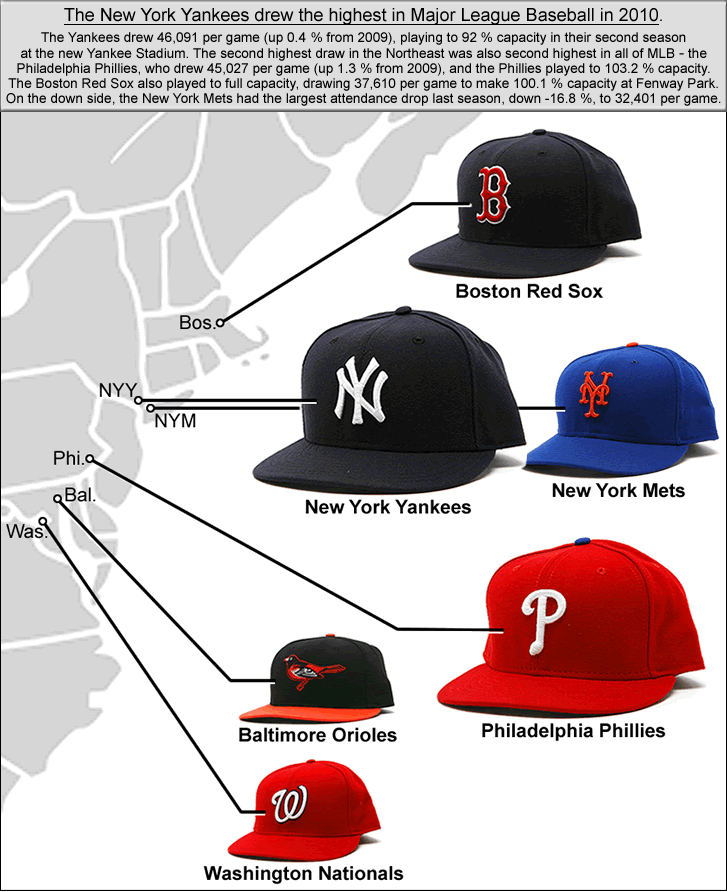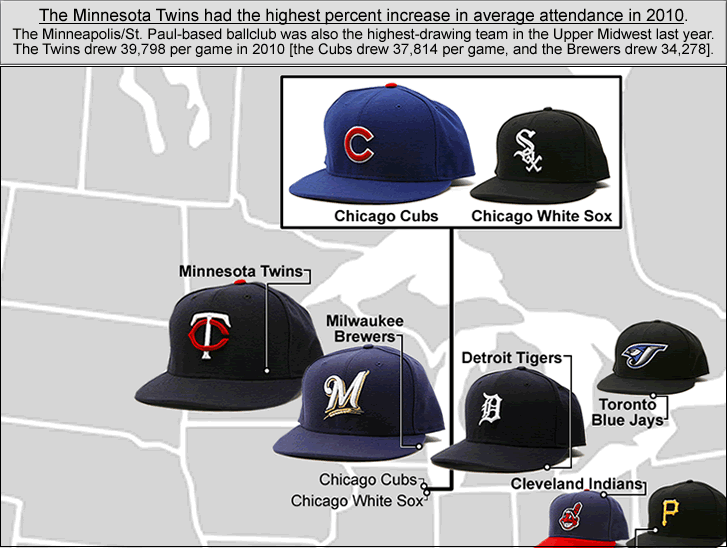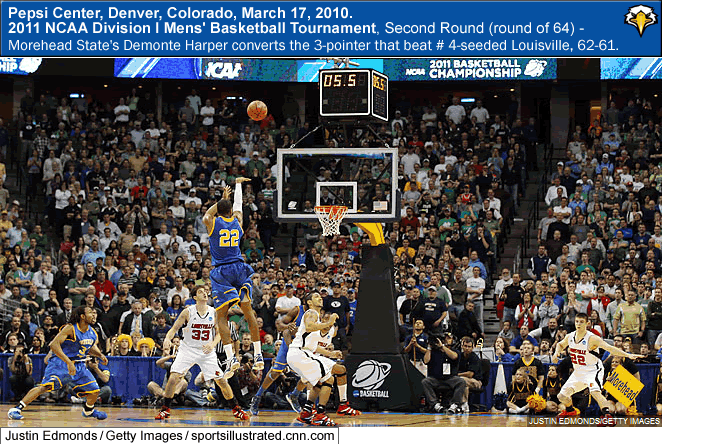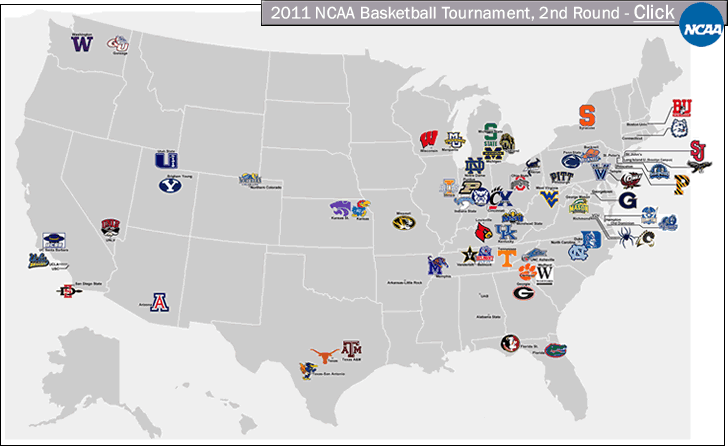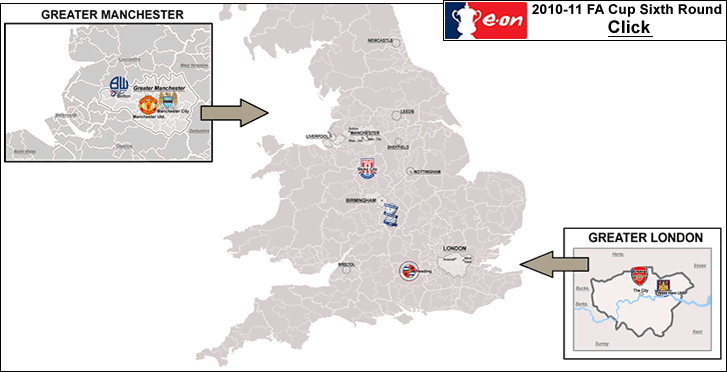[Note: to see my most-recent post on Mexican League baseball, click on the following: category: Mexico: Béisbol.
...
Click on image below for full map page of the Mexican League...
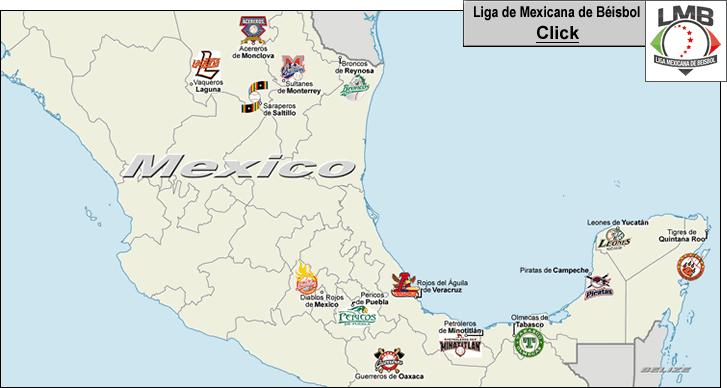
Mexican League
...
...
On the map...
On the map page, each team's profile box includes the team's year of formation, their ballpark and capacity, and their Mexican league titles (and year of last title). The team's home and away uniforms are also shown. At the lower left of the map of Mexico is the 2010 final standings and playoff results, and next to that is 2010 Mexican League teams' average home attendances.
...
The Mexican League is one of 3 Triple-A minor leagues in Organized Baseball. Unlike the other two Triple-A leagues, which are: the Pacific Coast League (based in the west and midwest of the USA), and the International League (based in the east and midwest of the USA), the Mexican League's teams are not affiliated with any of the 30 Major League Baseball clubs. In fact, the Mexican League has three minor leagues of its own, the Liga Norte de Mexico, the Liga de Beisbol del Noroeste de Mexico, and the Liga de Mexicana de Beisbol Academia (a winter league). The season is scheduled for 104 games, and runs from the middle of March, to mid-July, with the playoffs in late July/early August, then, in mid-August, the Serie Final (Final Series).
The Mexican League was founded in 1925, with 6 teams. The only original team that has survived to this day are Águilas Rojos de Veracruz (Veracruz Red Eagles), although there was a Mexico City team back then, and there is now a different, present-day Mexico City team - Diablos Rojos del México (Mexico City Red Devils), who were formed in 1940 and have won the most Mexican League titles, with 15 (their last title in 2008).
...
By the late 1930s, and into the 1940s, the Mexican League began to attract, via lucrative contracts and a more racially-tolerant atmosphere, a large contingent of top players from the Negro Leagues in America. Among the Negro League stars that crossed the border to play in Mexico were 'Satchel' Paige, Josh Gibson, 'Cool Papa' Bell and Ray Dandridge (all Baseball Hall of Fame members). During this era, Cuban-born players also arrived in numbers to play in the Mexican League. The combined effect of this was that Mexican-born players were pushed aside, as only a few, such as Angel Castro and Jesus Valenzuela, were competitive with the Negro League and Cuban players. And in 1946, white MLB players like Sal 'the Barber' Maglie and Hal Lanier were lured to play south of the border by fat contracts. But MLB put a stop to this with legal action in 1948, and at this point in time, with the 1947 breaking of the color barrier by Jackie Robinson, top drawer black ballplayers were able to join MLB teams, so the Mexican League ceased being a viable option. By the mid-1950s, the Mexican League was in dire financial straits. New owners in the ranks were instrumental in making the league part of Organized Baseball in the USA, first as a Double-A minor league circuit, then in 1967, the Mexican League became a Triple-A league.
...
Currently, there are 14 teams in the Mexican League (down from 16 teams in 2010). 2010 (and 2009) champions were Seraperos de Saltillo (Saltillo Serape Makers), who beat Pericos de Puebla (Puebla Parrots) 4 games to 1 in the 2010 Serie Final.
From Baseball de World.com, from 17 August, 2010, "Saltillo Seraperos Capture LMB Crown'.
From PitLane.mx, Agosto 18, 2010, 'Los bicampeones del beisbol mexicano...'
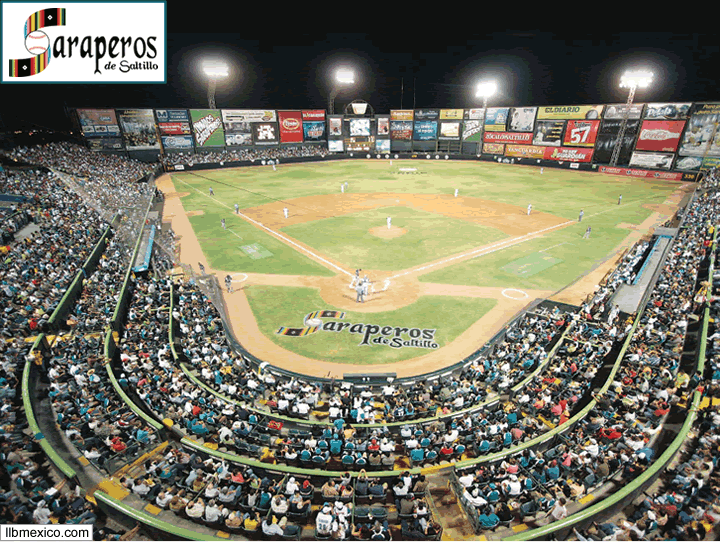
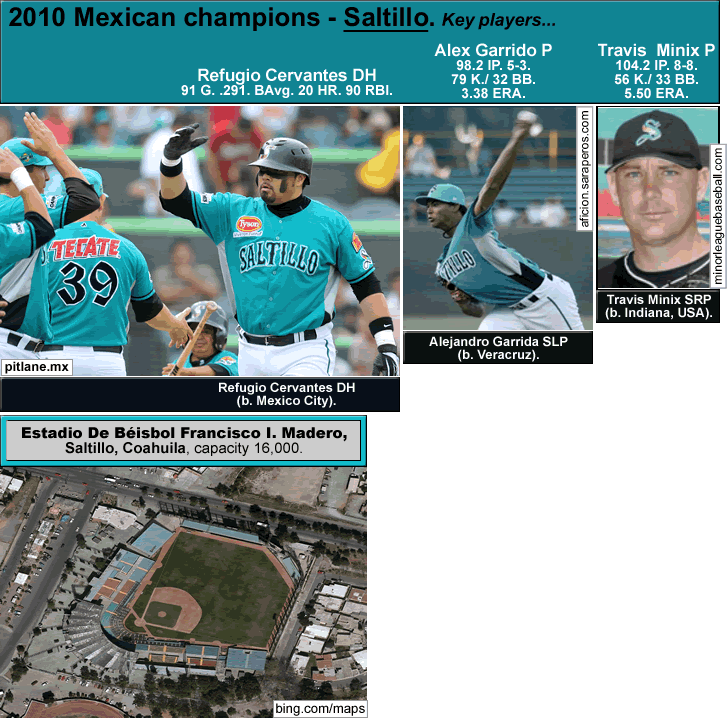
Photo credits - llbmexico.com Seraperos de Saltillo site. MinorLeagueBaseball.com/Travis Minix stats. PitLane.mx. Bing.com/maps.
Saltillo is the capital city of the state of Coahuila in northern Mexico, south and west of the southern panhandle of Texas, and 240 mi. (400 km.) west of Monterrey. Saltillo has a metro area population of around 725,000 {2005 census figure}. Its most famous exports are Saltillo tile, and the locally-woven, multi-colored zarapes (serapes). Saltillo has a sizable auto industry, with a GM assembly plant, a Chrysler truck assembly plant, and two engine facillities. I wouldn't say Saltillo is the Detroit of Mexico (with Saltillo boasting more scenic beauty and less urban decay), but 37% of the cars and 62% of the trucks produced in Mexico are assembled in Saltillo. The Saltillo Serape Makers draw pretty well by current Mexican League standards, pulling in 5,272 per game 2 seasons ago, and, 4,946 in 2010, when they just barely made it into the 8-team playoffs, but then over-achieved in the post-season, going on to win their second consecutive title. Saltillo actually drew in to the 10,000s in 2005 and 2006, and in the 9,000s in 2007. Within that time period, another nearby team, 9-time-title-winners Sultanes de Monterrey (Monterrey Sultans), were drawing 17,990 per game in 2006, 9,639 per game in 2007 when Monterrey won the title, and 12,424 per game in 2008. But owing to the global economic collapse in late 2008, Mexican League attendances plummeted in 2009 and 2010, pretty much across the board, with turnstile increases only in teams that were doing well that season, such as with the 2010 Zona Norte first-place Mexico City Red Devils, with a +1,641 per game increase (to 5,280 per game), and the 2010 Monterrey Sultans (who had the fourth-best record in 2010), with a +2,013 per game increase (to 6,731 per game). You can see just how bad the poor economy has affected Mexican baseball's drawing power, because Monterrey's average attendance last season was only 37% of what it was just 5 years ago. And the Mexican League's last expansion - in 2003, when it added 2 teams to make a 16-team league - that has been wiped away with the off-season demise of the Chihuahua Dorados and the Nuevo Laredo Owls.
...
Below is the list of Mexican League titles won by active ball clubs...
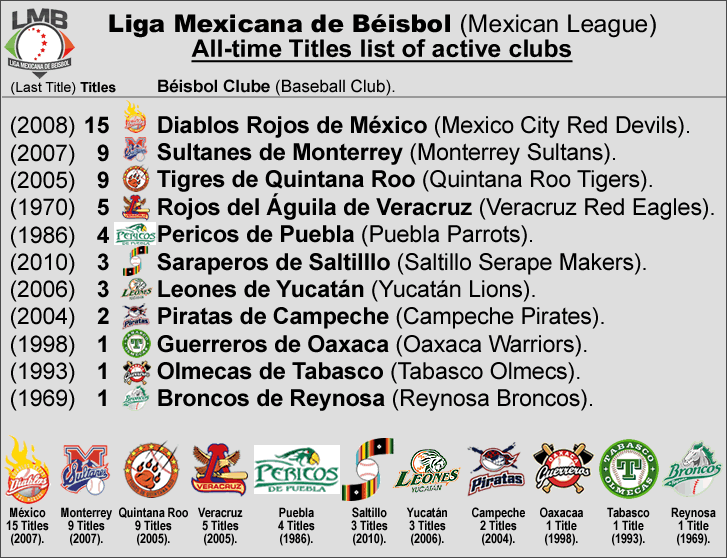
...
The Mexican League teams that make up the 2 divisions of -Zona Norte (North Division) and Zona Sul (South Division)
There is a cluster of 5 Mexican League teams in the north-east region of Mexico just south and west of Texas, including the aforementioned Saltillo Serape Makers and Monterrey Sultans. The other 3 teams in this cluster are Acereros de Monclova (Monclova Steelers), Vaqueros Laguna (Laguna Cowboys), and Broncos de Reynosa (Reynosa Broncos). Monclova Steelers have no titles, but draw well (highest attendance in 2009 at 8,114 per game; and 2nd highest draw at 5,304 per game last season). Laguna Cowboys also have no titles, and draw OK (6,014 per game 2 years ago). Reynosa is a city in the state of Tamaulipais, which is home to many of the foreign-owned factories known as the maquiladoras. Reynosa have 1 title to the franchise, but that was the first version of the team (which existed in the Mexican League from 1963 to 1976, and won the 1969 title). This third-version Reynosa Broncos (III) team came from Tijuana in 2009, as Potros de Tijuana (Tijuana Colts), who drew 8,361 per game in 2007, but 2 years later went bust, and were shipped by the league to Reynosa, Tamaulipas to re-start the Broncos franchise. (Basically they pulled a maneuver similar to what the Cleveland Browns (NFL) did, and contravened actual franchise-shift history and adopted the stats and titles of the old team. In other words, the Reynosa ball club are pretending they own the title that a previous Reynosa ball club won.) These 5 teams plus the aforementioned Mexico City and Puebla teams make up the Zona Norte. Puebla Parrots have won the fourth-most titles, with 4 titles (their last in 1986). Puebla moved over from the Zona Sur in the off-season to re-balance the league after the 2 teams dropped out. Now that those two teams (Nuevo Laredo and Chihuahua) are gone, the present Zona Norte teams look to have a considerably higher drawing power than the present Zona Sul teams.
The Zona Sul is made up of 5 teams which are strung out along the southern Gulf of Mexico coast, one team in the interior south of the capital, and one team on the coast facing the Caribbean. That last ball club is Tigres de Quintana Roo (Quintana Roo Tigers), of Cancún, Quintana Roo state, who are tied with Monterrey for the second-most titles, with 9 (their last title in 2005). The Tigres de Quintana Roo/Diablos Rojos de México rivalry is the biggest rivalry in Mexican baseball. The Zona Sul team from the interior is Guerreros de Oaxaca (Oaxaca Warriors), who moved from Mexico's second-largest city, Guadalajara, in 1996. Two years later, in 1998, Oaxaca won the title. The other 5 teams in Zona Sul are...the venerable but 40-years-on-without-a-title Veracruz Red Eagles; the title-less and least-supported Petroleros de Minatitlán (Minatitlán Oilers); one-time-title-winner (1993 title) Olmecas de Tabasco (Tabasco Olmecs); the perpetually cash-strapped/two-time title winners (last in 2004) Piratas de Campeche (Campeche Pirates); and the best-supported Zona Sul team, three-time title-winners Leones de Yucatán (Yucatán Lions), who won their third title in 2006. The Yucatán Lions' color scheme - dark green with orange trim - is an example of how in Mexican baseball, a considerable number of teams employ green, dark green, or teal as their primary color (5 teams), while the second-most popular primary color for a team is red (4 teams). This is like the colors of the Mexican flag. It's a counterpoint to the plethora of MLB teams in the USA who sport variations of the American flag's red, white, and blue [13 MLB teams total with variations/combinations of red-white-and-blue].
-
Thanks to Baseball-Reference.com.
Saltillo ballpark at night from llbmexico.com
Thanks to the contributors to the pages at en.wikipedia.org, and es.wikipedia.org, ‘Mexican League (baseball)‘.
Liga Mexicana de Béisbol
For the blank map of Mexico, thanks to Sémhur at Wikimedia Commons, ‘Mexico states blank map svg‘.
Thanks to Ballparkdigest.com, for 2010 Mexican League attendances, here (all minor leagues’ 2010 average attendances). Thanks to The Biz of Baseball.com for 2009 attendances.

